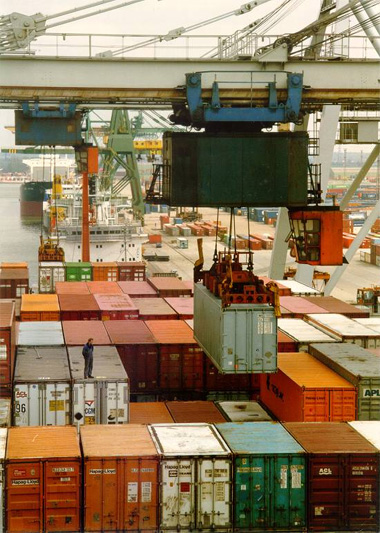Containerized cargo will double by 2021
 The load carried by containers in Brazilian ports will double in ten years. The sector is likely to grow 7.4 % per year between 2012 and 2021 . The expansion will cause the container volume may reach 14.7 million TEUs in 2021 , 90 % more than in 2011 , when the country moved 8.2 million TEUs . The high will be accompanied by an increase of sufficient capacity to meet demand in the period . Investments to accompany market growth can exceed R$ 10 billion in container terminals for public use, installed in ports organized to provide services to third parties.
The load carried by containers in Brazilian ports will double in ten years. The sector is likely to grow 7.4 % per year between 2012 and 2021 . The expansion will cause the container volume may reach 14.7 million TEUs in 2021 , 90 % more than in 2011 , when the country moved 8.2 million TEUs . The high will be accompanied by an increase of sufficient capacity to meet demand in the period . Investments to accompany market growth can exceed R$ 10 billion in container terminals for public use, installed in ports organized to provide services to third parties.
The projections contained in the study ” Ports 2021 – Assessment of Demand and Capacity Segment Container Port in Brazil .” The study was prepared by the Institute of Logistics and Supply Chain ( ILOS ) Custom Brazilian Association of Container Terminals Public Use ( Abratec ).
Of approximately R$ 10 billion that can be invested in container terminals for public use in ten year, $ 3.5 billion are approved for the 2012-2016 period , according to Abratec . There is still , according to the organization, forecasting R$ 1 billion to build two terminals in Suape ( PE ) and Manaus ( AM ) , and U.S. $ 6 billion in investment perspective for the period 2016-2021 . The expected reach R$ 10.5 billion.

Paulo Fernando Fleury , director general of ILOS , says the study separated the container terminals in systems or ” clusters ” , according to the geographical or market . The position of some terminals can make them overlap with others in choosing the scale vessels by shipping companies , says Luis Filipe Veiga also the ILOS . After analysis , the institute has defined seven ” clusters ” for container terminals for public use that were called Extremo Sul ( RS ) , South ( SC and PR ) , Santos ( SP ) , East ( RJ and ES ) , Northeast ( BA , PE and CE ) , North ( PA ) and Manaus ( AM ).
The conclusion of this work is that the ” clusters ” may have sufficient capacity to meet demand by 2021 if implemented the adaptations and expansions authorized by the respective port authorities, public enterprises management of ports , most companies docks . In conclusion, the ILOS says the ” cluster ” Sul, Santa Catarina , also can meet demand by 2021 . This region operates at the limit of their ability considering only the three terminals for public use ( TCP , APMT Itajaí and TESC ) .
But if they are also included in the analysis the mixed private terminals operating in Santa Catarina to move loads themselves and others, the occupancy rate of the terminals in the ” cluster ” South falls considerably. The work uses ILOS premised occupancy rate of 65 % in the terminals , ideal for providing good service level and avoid queues.

In Santos, the largest port in the country , the potential capacity of container terminals reaches 6.1 million TEUs in 2013 taking into account the entry into operation of Embraport new private mixed -use terminal at the port . Competition among container terminals for public use and private mixed is a theme that caused much discussion in recent years ( see story below).
The ILOS not entered the regulatory discussion . The study focused on projected capacity and demand in the next ten years. In the analysis of capacity, compared the companies together and took as a reference to the projections , the terminal had a market reference . The maximum potential capacity of this terminal was calculated according to certain assumptions , including the number of 25 moves per hour per portainer (used to move the containers on board the vessel ).
On the demand side , the estimates considered the long-range navigation , cabotage and the tendency to spend more products using container . Normally used to transport high-value products , containers have become useful for transporting bulk cargo such as sugar , coffee , pulp , steel products , orange juice and fertilizers , among others . Only this tendency toward containerization can increase annual volumes transported in a million TEUs
The study also showed that the Northeast is the region of the country that will have major growth in container handling with an average annual rate of 8.9 % by 2021 . Second is Manaus , with 8 %.
Source: Valor Econômico








